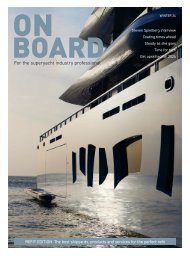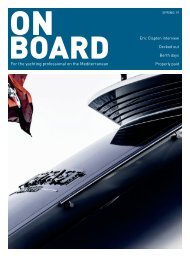ONBOARD Magazine summer 2021
The magazine is published quarterly and is the only publication aimed purely at the superyacht professional on the Mediterranean. Produced here on the Côte d’Azur, ONBOARD is a B2B industry magazine with a consumer feel. Designed to be entertaining and informative in equal balance, ONBOARD is packed with varied articles on superyacht paint & coatings, crew training, essential refit services, crew uniforms, shipyards, the very best superyacht chase boats, product launches and features from leading industry experts on relevant superyacht matters. If you need to get your products and services in front of the right crew and industry buyers, then talk to us.
The magazine is published quarterly and is the only publication aimed purely at the superyacht professional on the Mediterranean. Produced here on the Côte d’Azur, ONBOARD is a B2B industry magazine with a consumer feel. Designed to be entertaining and informative in equal balance, ONBOARD is packed with varied articles on superyacht paint & coatings, crew training, essential refit services, crew uniforms, shipyards, the very best superyacht chase boats, product launches and features from leading industry experts on relevant superyacht matters.
If you need to get your products and services in front of the right crew and industry buyers, then talk to us.
Create successful ePaper yourself
Turn your PDF publications into a flip-book with our unique Google optimized e-Paper software.
FOOD & DRINK
You can only perceive
four tastes - sweet, sour,
bitter, and salt - but the
average person can smell
over 2,000 different
scents, and wine has over
200 of its own
Swirl your wine around the glass
Why do we swirl the wine? To allow oxygen
to mix with the wine, releasing the esters,
ethers and aldehydes, which yield its
bouquet. In other words, swirling aerates
the wine and gives you a better overview
view of the aromas. Look at the colour
and especially the ‘legs’ that trickle down
the inside of the glass once the swirling
has stopped. The legs correspond to the
alcohol content, the longer the legs run
down the glass, the higher the alcohol
content. Musty, cloudy or unclear wine is
not good and should be returned or thrown.
Aroma
This is the most important part of wine
tasting. You can only distinguish four tastes
- but the average person can smell over
2,000 different scents, and wine has over
200 of its own. Now that you have swirled
the wine and released the bouquet, you
should smell the wine three times. The third
smell usually gives you more information
than the first smell did. Smell is a very
important step in the tasting process which
people simply don’t spend enough time on.
Pin-pointing the nose of the wine helps you
identify certain characteristics. The problem
here is, many people want someone else
to tell them what they are smelling. Am
I smelling citrus, apricot or straw? What
about black cherry, leather or tar? No one
knows what you are smelling, only what
they are smelling in their own glass with
their own nose. It can be different and you
have to have experienced a smell before you
know it actually exists, so if you’ve worked
around food or gardens before, then you’ll
pick up natural smells easier.
The best way to learn your own preferences
of wine styles, is to ‘memorise’ the smell
of the individual grape varieties. For white,
just try to memorise the three major grape
varieties: Chardonnay, Sauvignon Blanc, and
Riesling. Keep smelling them and smelling
them until you can identify the differences,
one from the other. For the reds, it’s a bit
more difficult, but you can still take three
major grape varieties: Pinot Noir, Shiraz
and Cabernet Sauvignon. Try to memorise
those smells.
Another interesting point while focusing
on smell is you are more likely to recognise
some of the defects of a wine through your
sense of smell. Following is a list of some
of the negative smells in wine:
• Vinegar/sherry - too much acetic acid
• Cork (dank, wet-cellar, musty smell,
oxidation - wine absorbs taste of
defective cork
• Sulphur - too much sulphur dioxide
Sulphur dioxide is used in several ways in
the winemaking process. It kills bacteria in
wine, prevents unwanted fermentation and
acts as a preservative. It often causes a
burning or itching sensation in your nose
if overused (as it is in many commercial
wines).
Taste
To many people, tasting means taking a
sip and swallowing immediately. This isn’t
tasting. Tasting is something you do with
your taste buds. Remember, you have taste
buds all over your mouth. They are on both
sides of the tongue, underneath, on the
tip, and they extend to the back of your
throat. If you simply take a gulp of wine
and throw it down your throat, you bypass
all those important taste buds.
It is important to determine where the
sensations of taste are taking place, and
specifically where they occur on your tongue
and in your mouth. Bitterness in wine is
usually created by high alcohol and high
tannin. Sweetness only occurs when there is
residual sugar left over after fermentation.
Sour or tart indicates the acidity in wine.
Here is where you ‘find’ these sensations
on your tongue.
Sweetness
Found on the tip of your tongue. It’s a
sensation you can taste right away.
Fruit characteristics
Found in the middle of the tongue.
Acidity
Found at the sides of the tongue, the cheek
area and the back of the throat. It’s most
commonly present in white wines.
Tannin
The sensation of tannin begins in the middle
of the tongue. Tannin frequently exists in
red wines or wood-aged white wines. When
the wines are too young, it dries the palate
to excess.
One thing you should also do as part of
your tasting is take a sip of wine and draw
a bit of air into your mouth along with it.
This opens up your retro-nasal passage and
further aerates the wine and helps bring
out the flavours in your mouth.
Texture
Texture is the feel of the wine in the mouth
- smooth, velvety or perhaps astringent are
common terms used to describe texture.
‘Creamy’ is a term often used to describe
the texture of rich wines that are low
in acid. The best wines will have a great
mouthfeel, being either silky or velvety in
texture. How do you know if a wine is a
good one or not? If you enjoy it, it is a good
one. Don’t let others dictate taste to you.
Balance
One of the most desired features in a wine
is good balance whereby the various flavour
components are in harmony with no individual
component (such as acidity, tannin or oak)
present in excess. When all the parts are
in harmony, the wine will have a sense of
elegance and completeness.
Finish
This is the last impression of the wine after
it is swallowed. How long does the wine’s
taste linger? Fine wines have a clean, long
finish. A lingering aftertaste is considered
a plus while a short finish or little, if any,
lingering aftertaste is undesirable.
With over 25 years of professional
experience in the wine industry, Brad
Mitton imports selected international wines
for leading sommeliers in Central Europe.
He is based in the South of France and
travels throughout Europe running gourmet
events with Club Vivanova.
Brad Mitton is the founder and owner
of Mitton International Wines (www.
mittonwines.com) based in Berlin and Club
Vivanova (www.clubvivanova.com) based in
Monte Carlo. Bradley recently launched the
start-up Brad’s Wine Subscription
(www.brads-wine.com) after demand for
monthly wine deliveries from his clients.
112 | SUMMER 2021 | ONBOARD
















